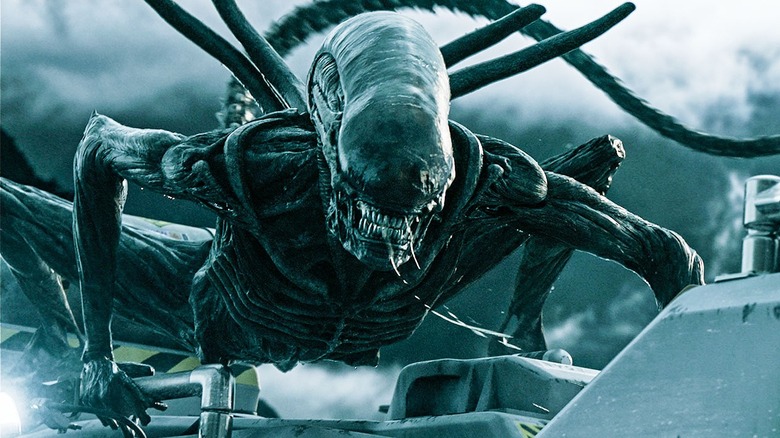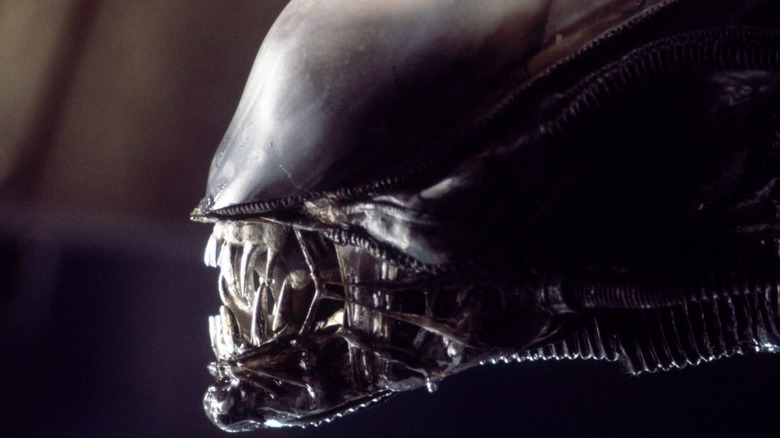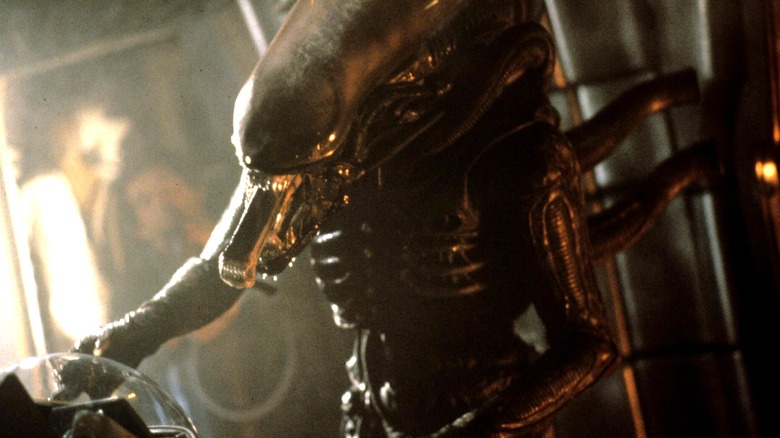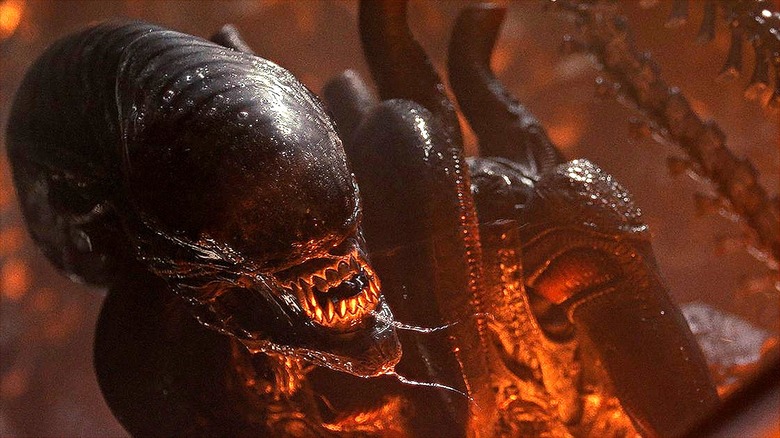Alien: Do Xenomorphs Have Eyes?
Of all the science fiction movies out there, few have created a monster as iconic and frightening to behold as director Ridley Scott's 1979 classic "Alien." The film's groundbreaking special effects were brought to life by visual effects pioneers Brian Johnson, Carlo Rambaldi, and other members of a team that received the film's sole Academy Award. The Alien, which is actually called a Xenomorph, is easily one of the most frightening creatures to ever grace the silver screen. However, despite its ferocity, it's lacking something.
Specifically, Xenomorphs do not have visible eyes, and the lone creature that terrorized "Alien" has no eyes at all. This is also true of the aliens' infant form, known as Facehuggers, which begs the question, 'Do Xenomorphs have eyes?' The simple answer to that question is, "No" ... but it comes with some caveats.
Xenomorphs have been a major part of popular culture for over 45 years, and a lot of creative people have worked on movies, comic books, novels, video games, and other projects featuring the creatures, each with their own unique spin. The Xenomorph in "Alien" and subsequently released movies don't have eyes, but they are able to see. Others have eyes that aren't visible to observers, so it's a bit complicated. While one filmmaker might prefer to go one way, others have kept closer to the original vision, making the general public's understanding of the Xenomorph's visual abilities a little fuzzy. Here, we'll break down how the iconic alien's form came about, why it has no visible eyes, and how it's able to see without them.
H.R. Giger designed Xenomorphs without eyes
It's fair to say from the outset that the Xenomorph's biology doesn't make much sense, but that doesn't detract from how frightening they appear. These monsters are covered in thick armor that allows them to survive the vacuum of space for an indeterminate period of time, possibly indefinitely. Furthermore, their blood is so acidic that it burns through anything it touches — except for other Xenomorphs. In "Aliens," simply shooting them causes acid to blast out and coat large areas, causing widespread destruction and making them capable of killing even in death.
The creatures were designed with the intent of them being imposing and horrifically intimidating, and that's precisely what they are. The man responsible for the Xenomorph's appearance is Swiss artist H.R. Giger, whose designs inspired the entire look of the film's creatures and sets. Giger initially drew the Xenomorph with large, insect-like eyes on the front of its head-dome, but he quickly discarded this in favor of the version that made it into the movie.
His reason for removing the eyes had to do with the creep factor an eyeless monster projects. Giger felt that it was far scarier to present a monster whose victim couldn't tell if it was looking directly at them. He dumped the eyes and came up with a semi-translucent dome. This leaves the audience watching a creature that's not only imposing but insidious in its ability to intimidate and instill fear in anyone who sees it.
The Xenomorph in Alien doesn't have eyes
Giger's design used in "Alien" doesn't feature eyes at all, within or outside of its skull, begging the question, "How did the Xenomorph see?" We watch it hone in on a victim and hold them in place long enough to shatter their skull, killing them, but it isn't clear how they're able to do this without some means of seeing their victims. There are various schools of thought regarding how Xenomorphs perceive their environments, and thanks to the plethora of related media published and produced over the years, we have some answers.
It's clear Xenomorphs don't see in the same way humans do, relying instead on a combination of their other senses. It's believed that they "see" using enhanced hearing and smell to utilize echolocation and detect pheromones when hunting their prey. They also sense changes in air pressure and the electrical impulses in human bodies to identify targets, so they can see just fine — they just do so without any ocular organs.
In "Aliens: Hive," a four-issue miniseries published by Dark Horse Comics in 1993, a character reflects on an imposing Xenomorph, hoping to elude the beast. The dialogue box reads, "Now she cursed both light and sound. The eyeless face cared nothing for such specialized perceptions. It used the old senses ... vibration, electricity, fear." The comic doesn't go into much detail, but one thing is certain: Xenomorphs don't have eyes ... at least, they didn't at this point in the franchise's history.
Later films feature Xenomorphs with eyes hidden inside their skulls
As new films were added to the franchise, the titular alien race evolved, and its design changed in various ways. Xenomorphs' bodies are dependent on the organisms from which they are born, so in "Alien 3," the so-called "dog alien" that gestated inside of a canine host ran mostly on all fours. As the franchise progressed, even more types of Xenomorphs entered the landscape, including the Newborn in "Alien: Resurrection," which has eyes similar to a human's thanks to being the offspring of a Queen Xenomorph fused with DNA from a Ripley (Sigourney Weaver) clone.
Eventually, some Xenomorphs sported eyes set into the skull protected by the creature's translucent dome. If you've ever seen a barreleye fish, which has a transparent head and eyes set within, it's akin to that, though the alien's eyes aren't visible to outside observers. In this design, Xenomorphs do have eyes and can see, but that detail is almost moot since the organs remain unseen by the creatures' prey, and their behavior doesn't give away the fact that they have sight.
Further development of the original design has continued this trend in various ways. In "Alien: Romulus," another human-Xenomorph hybrid, the Offspring, appears more akin to a human than a Xenomorph. As "Alien" sequels continue to embrace alterations to Giger's Xenomorph, they move beyond the original concept of his design and, as a result, further away from the eyeless beasts that kept us all up at night for the past five decades.



